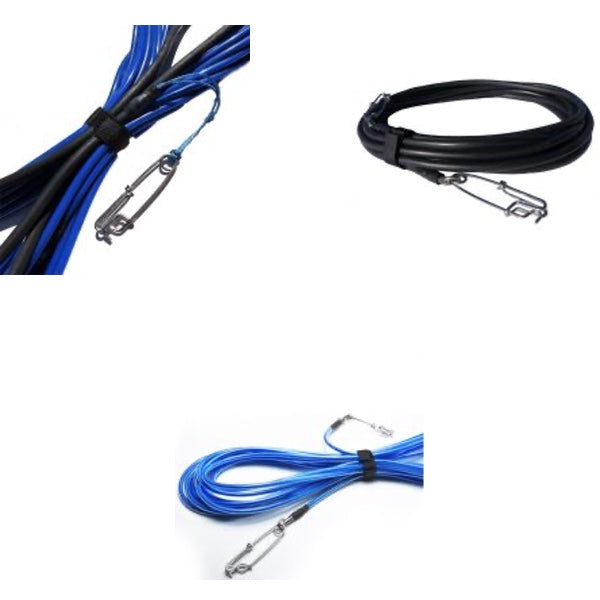
Picking the Right Bungee for Your Bluewater Rig
The purpose of large bungees is to allow gradual pressure when fighting a fish. By having some slack in your floatline setup, bungees keep your fish from running into a wall when they take off after you shoot them. If they run into a static line from your floatline they can pull the spear shaft out of themselves, resulting in a wounded and lost fish. The right bungee for you is going to be based on the type of fish you are targeting and the size of float you are using.
Bungee Design
A standard tuna bungee will stretch to twice its starting length. They have a 1600 pound spectra core that is spliced on both ends to floatline plugs. The floatline plugs ensure the interior of the bungee remains sealed and dry. In effect, they can be used as floatlines by themselves. The Neptonics Tuna bungees are paired well with the Neptonics Floatline Clutch. The Neptonics 6 foot and 10 foot bungees, on the other hand, are not sealed and will allow water into the bungee. It still is very effective for applying gradual pressure to a fighting fish, but will sink on its own.
Types of Fish
Certain types of fish are found in deeper water. If there is not structure that the fish can rub a tuna bungee against, it makes a lot of sense to just use a tuna bungee without a floatline. Many species of tuna are prefect opportunities for this. The only downside of a tuna bungee is that it can be cut in the wreck or reef, but if there's no structure around you can take advantage of all of its strong points. If you are going to be around structure, a vinyl coated floatline like the Bluewater Pro, Pressure Pro, or Stretch Floatline may be your best options for keeping your gear safe.
Back Pressure Testing Numbers
The amount of pressure and force it takes to stretch these floatlines is important because of the amount of force it takes to submerge a float. You want the most gradual increase of pressure as possible before the float starts to go under water. You increase your risk of gear failure if there is a sudden amount of pressure to your equipment. Below is a breakdown of the amount of force it takes to stretch each of our bungees and floatlines that allow for stretch.*These tests were done outside the water. There is some variability in the building process of any given product. These numbers are essentially estimates.
Neptonics Bungees:
6 Foot (Same for Pressure Pro) - 22 lbs (10 Kg)10 Foot- 24 lbs (10.9 Kg)
Neptonics Tuna Bungees:
25 Foot - 27 lbs (12.3 Kg)
50 Foot - 24 lbs (10.9 Kg)
75 Foot - 29 lbs (13 Kg)
100 Foot - 35 lbs (15.9 Kg)
Stretch Floatline:
50 Foot - 25 lbs (11.5 Kg)
75 Foot - 28 lbs (13 Kg)
100 Foot - 26 lbs (12 Kg)
120 Foot - 29 lbs (13.5 Kg)
What the Numbers Mean for Your Setup
Based on these tested numbers we are able to better determine the ideal blue water spearfishing rig. Using the numbers from the Neptonics Spearfishing Academy: Choosing the Right Spearfishing Float For You - Advanced we can pick the right bungee to ensure a more gradual build up of back pressure. The biggest question for your initial bungee/floatline still comes down to the depth you will be diving. From there your first float should be a hard float, like the Rob Allen 12 Liter Foam Filled Float, which displaces about 27 lbs of water. That means the 75 foot tuna bungee and all of the stretch floatlines will start to submerge the float just as they reach the limit of their stretch.If you are targeting big tuna this is still a good start. Your first float should start to submerge before a 100 foot bungee has fully stretched. The 3 ATM float connected by a 10 foot bungee will quickly take the stretch out of both of these bungees. The two bungee system should allow for the gradual back pressure needed to prevent major gear failures from a fish sounding suddenly.
